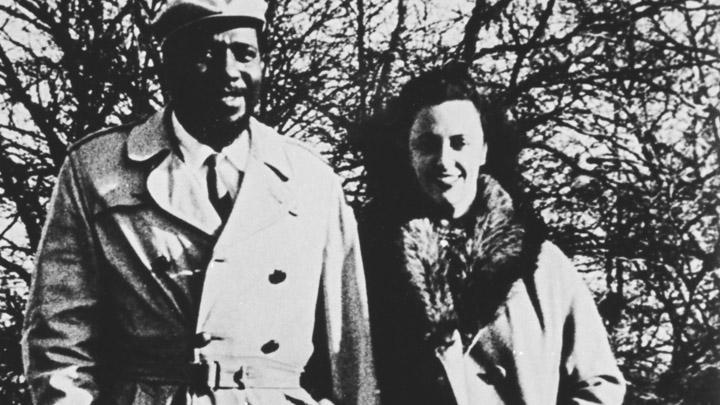 |
| The jazz composer Thelonius Monk and his "butterfly", the Baroness Katherine Anne Pannonica Rothschild |
"Softer than silk, and as warm as warm milk
light as air and able to fly,
Blossoms know bliss, while they're waiting for her kiss,
Pannonica my butterfly,"
The poetic image of butterflies has served as inspiration to a number of jazz composers in the 20th century, from the virtuoso piano bop of Art Tatum through the musings of Thelonius Monk and the fusion and funk of Herbie Hancock.
Art Tatum was a blind blues pianist who played in the bop style, leading runs and arpeggios up and down the keyboard that would have been the envy of any European concert virtuosi. "Just Like a Butterfly (That's Caught in the Rain)" finds the soloist in a ruminative mood, creating dazzling textures with just ten fingers before settling into a groove briefly, then launching another torrent of notes. He is one of the most influential pianists of the century, and hos music showed the way for players like Bud Powell, Oscar Peterson and McCoy Tyner.
The Puccini opera Madama Butterfly may have inspired "Poor Butterfly", a sweet blues. Check out Coleman Hawkins' 1960 recording on Blue Note (currently available on At Ease With Coleman Hawkins. The tune is carried by the Hawk's trademark tone, rich and mellow with smooth melodic runs and agile maneuvers through the tenor saxophone's wide range. Hawk is answered by an eloquent piano solo.
"Like the lovely flowers, I'll wait for hours
Just to feel that touch the touch that I love so much
One day, she'll flutter by
I'll hold out my hand and capture my butterfly,"
Thelonius Monk wrote "Little Butterfly", an even sadder minor blues with lovely, poetic lyrics and a brilliant, lengthy electric bass solo in the middle against the piano. The song is also known as "Pannonica", and is dedicated to Monk's patron, the Baroness Katherine Anne Pannonica Rothschild, who enjoyed a friendship with the composer that lasted 28 years.
It has become a jazz standard, especially as sung by Carmen McRae on the classic Carmen Sings Monk:
"Delicate things such as butterfly wings,
Poets can't describe though they try
Love played a tune when she stepped from her cocoon
Pannonica, my butterfly"
Flash forward to the 1970s, and we come to "Butterfly", an epic 11-minute jam from the Herbie Hancock album <i>Thrust.</i> From its opening statement, a mournful saxophone theme over a hi-hat and bass vamp, "Butterfly" establishes itself as one of Mr. Hancock's most melodic compositions. The final movement is a sort of duel between synthesizer, electric piano and the horn section, which interrupts the easy virtuosity on display to offer comments on the main theme.
No comments:
Post a Comment